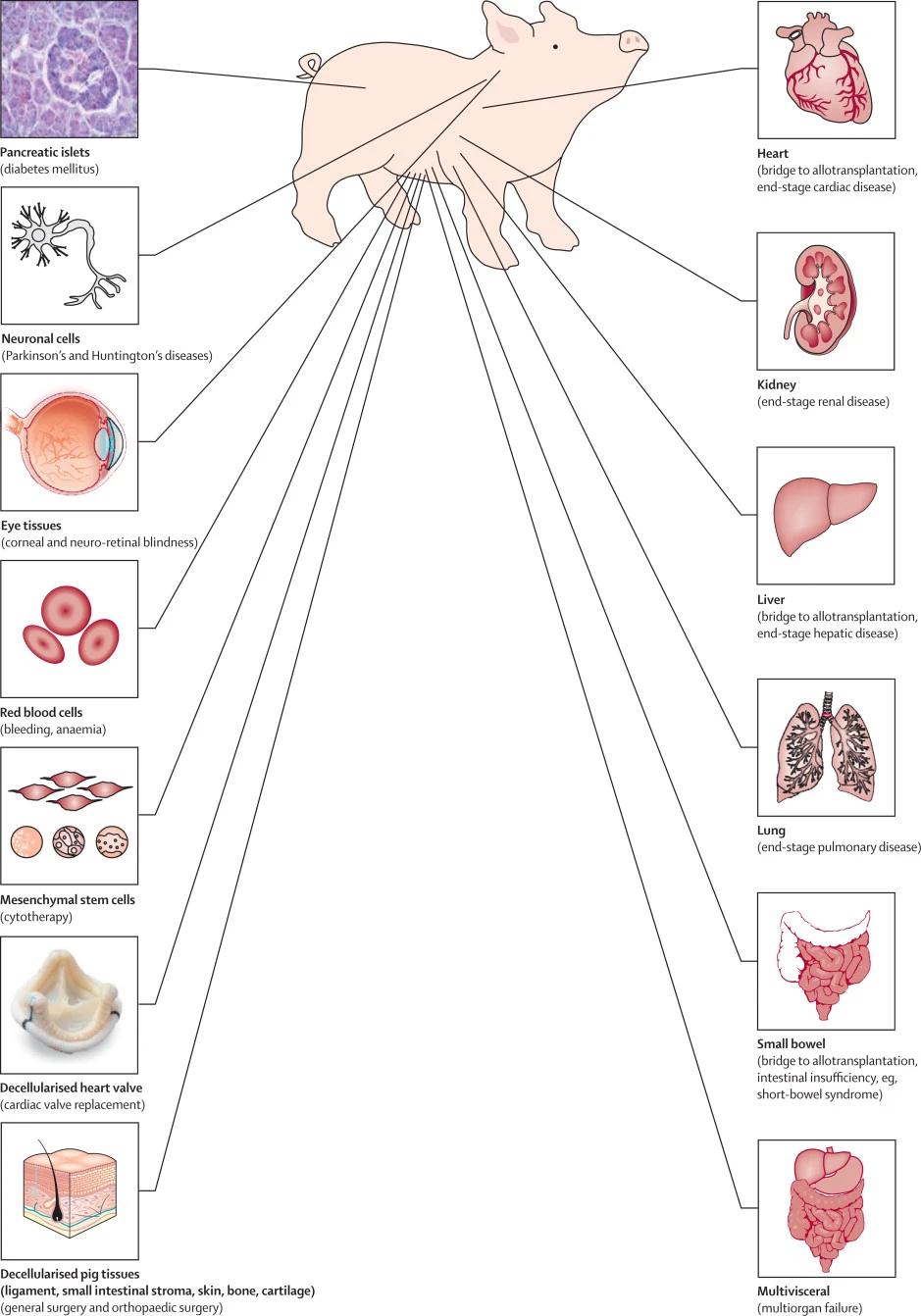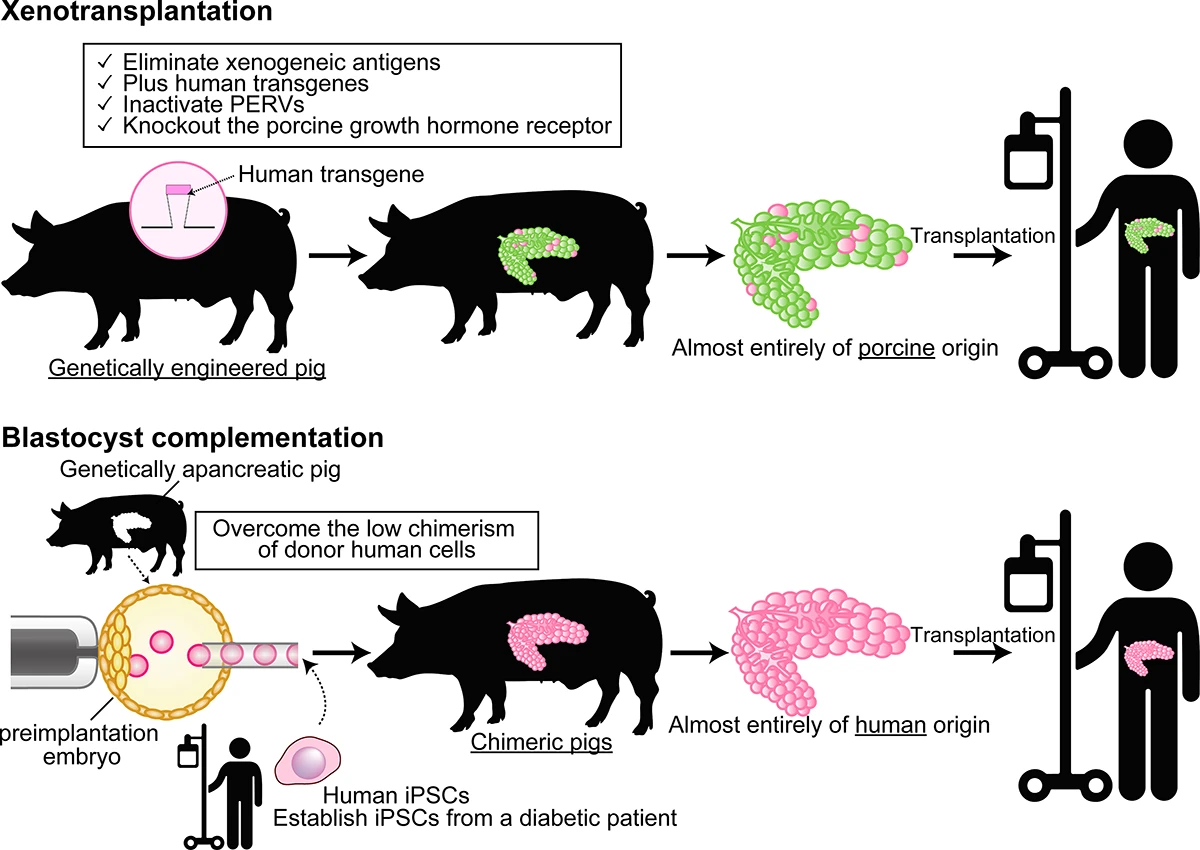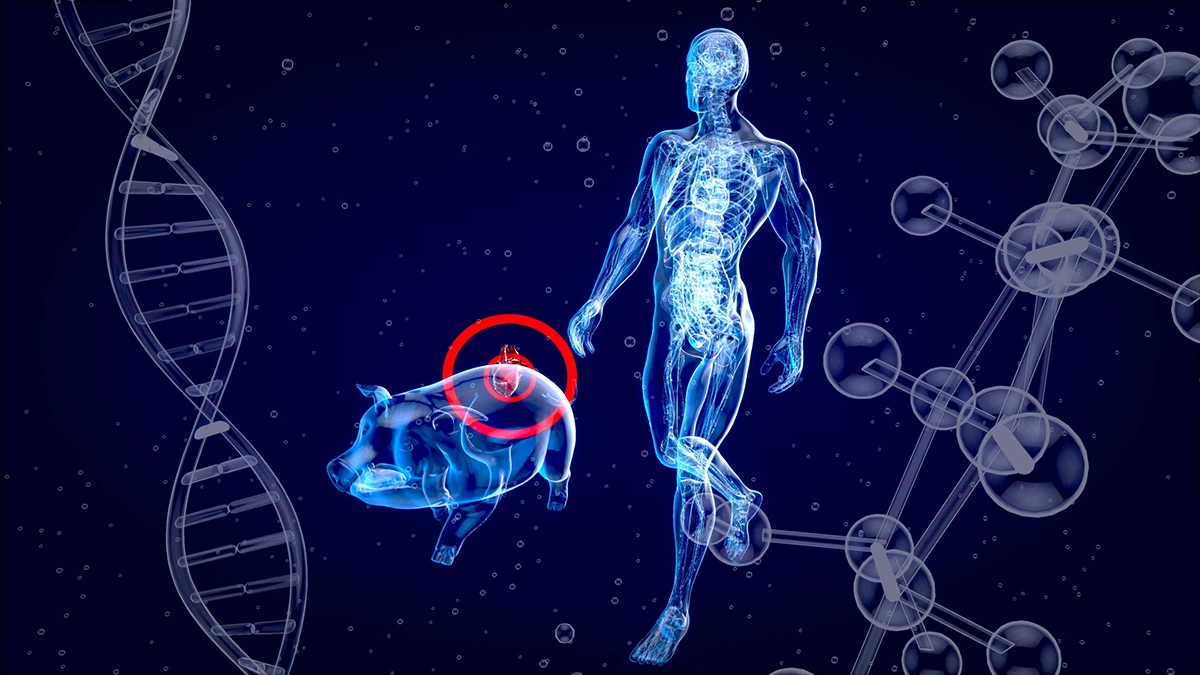The Future of Xenotransplantation

Xenotransplantation is the transplantation of living cells, tissues, or organs from one species to another, such as pigs to humans. The prefix “xeno-” is derived from the Greek word “xenos,” meaning foreign or strange, highlighting the cross-species nature of the procedure. The goal of xenotransplantation is to address the shortage of organs available for human transplantation by utilizing organs or tissues from animals, such as pigs, that are physiologically and anatomically similar to humans.
One of the significant challenges it tries to solve is the risk of hyperacute rejection. This severe immune response occurs when the recipient’s body recognizes the foreign tissue as incompatible. To overcome this problem, scientists are developing transgenic pigs, which are genetically modified to reduce the immune reaction. Recently, researchers reported the first successful transplant of genetically modified pig kidneys into a brain-dead human, demonstrating the feasibility and safety of this procedure.
It is still an experimental and controversial field, but it has the potential to save many lives and improve the quality of life for patients with end-stage organ failure. It is also known or related to heterologous, zoonotic, and interspecies transplantation.
Practical Applications
Some of the practical applications of xenotransplantation are:
- The use of fetal pig neuronal cells to treat Parkinson’s disease.
- The use of genetically modified pig liver to treat liver failure.
- The use of baboon bone marrow transplant to treat HIV.
- The use of fetal calf adrenal cells to provide pain relief for end-stage cancer.
- The transplant of pancreatic islet cells from pigs to treat insulin-dependent diabetes in humans.
Importance for Our Future
Xenotransplantation is important for our future because it can potentially address the worldwide organ shortage crisis, which affects millions of people who suffer from end-stage organ failure. Using animal organs, such as genetically modified pig kidneys, as a substitute or a bridge for human organs can save lives and improve the quality of life for patients who need organ transplants. It can also provide a platform for studying human diseases and testing new therapies. However, it poses many challenges and ethical issues, such as the risk of zoonotic viral transmission, immunological rejection, animal welfare, and public acceptance.

How Does It Work?
Here is the step-by-step overview of xenotransplantation process works:
- A suitable animal donor, usually a pig genetically modified to reduce immune rejection and the risk of disease transmission, is selected.
- The animal organ, cell, or tissue is harvested and prepared for transplantation, implantation, or infusion into the human recipient.
- The human recipient undergoes the xenotransplantation procedure, which may involve surgery, injection, or infusion.
- The human recipient receives immunosuppressive drugs and other medications to prevent or treat immune rejection and potential infections.
- The human recipient is monitored closely for the function and survival of the xenograft, as well as the possible complications and side effects.
Evolve in the Future
Some of the possible ways that xenotransplantation can evolve in the future are:
- Improve the genetic engineering of donor animals, such as pigs, to make their organs more compatible with human immune systems and reduce the risk of disease transmission.
- Develop new immunosuppressive drugs and strategies to prevent or treat immune rejection and the potential infections that may occur after xenotransplantation.
- Explore using stem cells, organoids, or bioartificial organs as alternative sources of transplantable tissues derived from human or animal cells.
- Establish clear and consistent regulations and guidelines for xenotransplantation’s ethical, legal, and social aspects, such as animal welfare, public acceptance, and informed consent.
Help Organizations/Enterprises
Xenotransplantation can help organizations and enterprises in various ways, such as:
- Provide a potential solution for the organ shortage crisis, which affects millions of people who suffer from end-stage organ failure. This can reduce the mortality and morbidity rates, as well as the healthcare costs associated with organ failure and transplantation.
- Offer a platform for studying human diseases and testing new therapies, especially for those challenging to model in conventional animal models or human cell cultures. This can accelerate the development and innovation of new drugs and treatments for various conditions.
- Create new opportunities and markets for the biotechnology and pharmaceutical industries, animal breeding, and farming sectors. This can generate economic growth and employment and foster stakeholder collaboration and competition.
Driving Adoption
One of the main factors driving the adoption of xenotransplantation is the increasing demand for human organs for clinical transplantation, which far exceeds the supply. According to the U.S. Department of Health and Human Services, more than 100,000 people are on the national transplant waiting list as of November 2021, and 17 people die each day waiting for an organ.

Operational Challenges
Some of the major challenges in xenotransplantation adoption are:
- The risk of zoonotic viral transmission is the possibility of transferring infectious agents from animals to humans through xenotransplantation. This could seriously threaten the health of the recipients, the public, and the environment.
- The immunological rejection is the human body’s immune response against foreign animal tissues or organs. This could lead to the failure of the xenograft and the damage of the recipient’s organs. To prevent or treat this, the recipients must take immunosuppressive drugs, which have side effects and increase the susceptibility to infections.
- The ethical and social issues involve the moral, legal, and cultural aspects of using animal sources for human benefit. These include respect for animal welfare, informed consent from the recipients and donors, public acceptance and trust, and regulation and oversight of xenotransplantation procedures.
Success Stories
Some of the success stories of xenotransplantation are:
- In 2022, the first organs taken from genetically engineered pigs were transplanted into humans, demonstrating the feasibility and safety of this procedure. A pig kidney was attached to the blood vessels of a brain-dead human and functioned normally for 54 hours. A pig heart was implanted into a patient with terminal heart failure and supported his life for two months.
- In 2020, a patient with type 1 diabetes received a transplant of encapsulated pig islet cells, which produce insulin. The treatment was successful and allowed the patient to reduce insulin injections.
- In 1996, a patient with Parkinson’s disease received a transplant of fetal pig neuronal cells, which produce dopamine. The treatment improved the patient’s motor function and quality of life.
- In 1984, a patient with HIV received a bone marrow transplant from a baboon, which was resistant to the virus. The treatment did not cure the patient, but it reduced the viral load and delayed the progression of AIDS.
Types
There are four main types of xenotransplantation procedures:
- Solid-organ xenotransplantation: This is when a whole organ, such as a kidney or a heart, from an animal donor, is transplanted into a human recipient. Pigs are the most promising source of animal organs, as they are widely available and have organ sizes similar to humans.
- Cellular and tissue xenotransplantation: This is when animal cells or tissues, such as pancreatic islets or neuronal cells, are implanted or infused into a human recipient without connecting any blood vessels. It can be used to treat conditions like diabetes or Parkinson’s disease.
- Extracorporeal perfusion: This is when human blood is circulated outside the body through an animal organ, such as a liver or a bioartificial organ, which is made by culturing animal cells on an artificial matrix. It can temporarily support the function of a failing organ.
- Cellular and tissue xenotransplantation exposure to living animal-derived material: This is when human body fluids, cells, tissues, or organs are removed from the body, come into contact with animal cells, tissues, or organs, and then placed back into the human body. It can be used to modify or enhance the properties of the human material.

Advantages
Here are the advantages of xenotransplantation are:
- It promises life-saving benefits by providing humans with unlimited cells, tissues, and organs.
- It reduces opportunities on the black market for organ donations and the use of organs from executed prisoners.
- It has the potential to open up new research areas and treat diseases that are not treatable by human-to-human transplantation.
- It does not require consent from an animal that can be sacrificed for the organ.
Disadvantages
Some of the disadvantages of xenotransplantation are:
- It has a low success rate and a short lifespan of animal organs, which could limit the effectiveness and durability of the treatment.
- It raises moral and ethical issues, such as the respect for animal welfare, the informed consent of the recipients and donors, the public acceptance and trust, and the regulation and oversight of the xenotransplantation procedures.
- It poses a high risk of disease transmission from animals to humans, which could cause severe infections or new pandemics.
- It triggers a strong immune rejection from the human body against foreign animal tissues or organs, which could lead to the failure of the xenograft and damage to the recipient’s organs.
Ethical Concerns
Xenotransplantation raises many ethical concerns, such as:
- The respect for animal welfare, as the animals may suffer from genetic modification, breeding, harvesting, and experimentation.
- The informed consent of the recipients and donors, as they may not be fully aware of the risks and benefits of xenotransplantation.
- The public accepts and trusts it, as society may have different views and values on using animal sources for human benefit.
- The regulation and oversight of the xenotransplantation procedures as they may involve legal, social, and environmental implications.
- The risk of disease transmission from animals to humans could cause serious infections or new pandemics.
- The immunological rejection from the human body against the foreign animal tissues or organs could lead to the failure of the xenograft and the damage of the recipient’s organs.
Governance and Regulation
Different countries have different approaches to govern and regulate xenotransplantation. Some of the common elements are:
- Establish a national authority or committee to oversee and coordinate xenotransplantation activities, such as the Food and Drug Administration (FDA) in the United States or Health Canada in Canada.
- The development of specific guidelines and standards for the preclinical and clinical evaluation of xenotransplantation products, such as the FDA Guidance for Industry or the Canadian Guidance Document.
- The rigorous approval process for initiating and conducting xenotransplantation clinical trials requires the review and authorization of the national authority, the institutional review board, and the ethics committee.
- Implementing a comprehensive surveillance and monitoring system for detecting and preventing infectious diseases and adverse events associated with xenotransplantation involves reporting and tracing the recipients, donors, and products.
- The promotion of public involvement and consultation enhances the transparency and accountability of the xenotransplantation activities and assesses the social and ethical acceptability.
Xenotransplantation is still experimental and controversial, facing many challenges and uncertainties. Therefore, it is important to develop a harmonized and adaptive regulatory framework that can balance the potential benefits and risks and foster international collaboration and coordination among various stakeholders.
History
Xenotransplantation has a long and controversial history, dating back to the 17th century. Here are some of the key events in the history of xenotransplantation:
- 1667: The French doctor Jean-Baptiste Denys performed the first xenotransfusion, using blood from a lamb to treat a boy with fever. The boy survived, but later attempts resulted in deaths, and Denys was accused of murder.
- 1905-1906: The French surgeon Mathieu Jaboulay attempted the first xenografts of kidneys from pigs and goats into humans. The transplants failed due to hyperacute rejection, a severe immune response when the recipient’s body recognizes the foreign tissue as incompatible.
- 1963-1964: The American surgeon Thomas Starzl performed the first xenotransplants of kidneys and livers from chimpanzees and baboons into humans. The recipients survived for several days to months, but the immune system rejected the transplants and caused infections.
- 1984: The American surgeon Leonard Bailey performed the first xenotransplant of a heart from a baboon into a newborn girl, known as Baby Fae. The surgery was successful, but the baby died after 21 days due to acute rejection.
- 1992: The American surgeon Thomas Starzl performed the first xenotransplant of a liver from a baboon into a man with hepatitis B. The transplant was rejected after 70 days, but the man survived for another 26 months with his liver.
- 1995-1997: The American company Diacrin performed the first clinical trials of xenotransplantation of fetal pig cells into patients with Parkinson’s, Huntington’s, and stroke. The trials showed some improvement in the symptoms but raised concerns about the risk of transmitting porcine endogenous retroviruses (PERVs) to humans.
- 2000-2005: The New Zealand company Living Cell Technologies performed the first clinical trials of xenotransplantation of encapsulated pig islet cells into patients with type 1 diabetes. The trials showed some insulin requirement reduction but faced ethical and regulatory challenges.
- 2015-2018: The American company eGenesis used CRISPR gene editing to create pigs that are free of PERVs and have humanized genes to reduce immune rejection. The company also performed preclinical studies of xenotransplantation of pig kidneys and lungs into primates, showing promising results.
- 2022: The American surgeon Robert Montgomery performed the first xenotransplant of a genetically modified pig heart into a man with end-stage heart failure. The transplant was successful, and the man survived for two months, demonstrating the feasibility and safety of this procedure.
Tools and Services
Some of the tools and services that are involved in xenotransplantation are:
- Genome engineering tools, such as CRISPR/Cas9, allow the genetic modification of donor animals to reduce immune rejection and the risk of disease transmission.
- Proteomic tools like mass spectrometry enable the analysis of xenografts and recipients’ differential protein expression.
- Immunohistochemistry tools, such as antibodies, allow the specific detection of animal-derived antigens in xenografts.
- Flow cytometry tools, such as fluorescent probes, measure the xenoantibodies and complement activity in xenotransplantation.
- Cell culture tools, such as bioreactors, allow the generation and maintenance of animal cells, tissues, or organs for xenotransplantation.
- Surgical tools, such as vascular anastomosis devices, facilitate the transplantation, implantation, or infusion of animal organs, cells, or tissues into human recipients.
- Monitoring tools, such as imaging devices, assess the function and survival of xenografts and the possible complications and side effects in recipients.

How to Get Started?
To get started with xenotransplantation, you would need to:
- Learn about the basic concepts, principles, and challenges of xenotransplantation, such as the types, sources, methods, the risk of disease transmission and immune rejection, and the ethical and social issues involved.
- Explore the current research and development of xenotransplantation, such as using genome engineering tools to create genetically modified pigs, the preclinical and clinical evaluation of xenotransplantation products, and the surveillance and monitoring system for infectious diseases and adverse events.
- Follow the guidelines and standards for the governance and regulation of xenotransplantation, such as the FDA Guidance for Industry, the Canadian Guidance Document, and the international consensus documents.
- Engage with public involvement and consultation to enhance xenotransplantation’s transparency and accountability and assess the technology’s social and ethical acceptability.
Best Practices
Some of the best practices for getting the most from xenotransplantation are:
- Use genome engineering tools, such as CRISPR/Cas9, to create genetically modified pigs that are more compatible with human immune systems and less likely to transmit diseases.
- Follow the guidelines and standards for the preclinical and clinical evaluation of xenotransplantation products, such as the FDA Guidance for Industry or the Canadian Guidance Document.
- Implement a comprehensive surveillance and monitoring system for detecting and preventing infectious diseases and adverse events associated with xenotransplantation.
Related Terms
Some of the terms related to xenotransplantation are:
- Xenograft: A transplant of living cells, tissues, or organs from one species to another, such as pigs to humans.
- Xenozoonosis: The transmission of infectious agents from animals to humans through xenotransplantation, which could cause serious diseases or pandemics.
- Hyperacute rejection: A severe immune response that occurs when the recipient’s body recognizes the foreign tissue as incompatible and destroys it within minutes or hours.
- Transgenic animal: An animal genetically modified to introduce or remove specific genes, such as those that reduce immune rejection or the risk of disease transmission.
- Encapsulated cell: A cell surrounded by a protective coating or membrane that prevents the immune system from attacking it.
- Bioartificial organ: An artificial organ made by culturing animal or human cells on a synthetic matrix or scaffold.
Learn more
Research Papers
- Xenotransplantation: A New Era by Amber N. Carrier, Anjali Verma, Muhammad Mohiuddin, Manuel Pascual, Yannick D. Muller, Alban Longchamp, Chandra Bhati, Leo H. Buhler, Daniel G. Maluf, and Raphael P. H. Meier: Provides a brief overview of the recent progress in xenotransplantation research, mainly concerning using porcine heart, renal, and liver xenografts in clinical practice.
- Xenotransplantation: The Contribution of CRISPR/Cas9 Gene Editing Technology by Zoe A. Stewart: Highlights how gene editing technology using CRISPR/Cas9 has revolutionized the xenotransplantation field, leading to the first pig-to-human kidney and heart xenotransplants.
- CRISPR/Cas Technology in Pig-to-Human Xenotransplantation Research by Natalia Ryczek, Magdalena Hryhorowicz, Joanna Zeyland, Daniel Lipinski, and Ryszard Słomski: Summarizes the advantages and achievements of the CRISPR/Cas system in pig-to-human xenotransplantation research, as well as the barriers and limitations that require careful evaluation before attempting to experiment with this technology.
- Xenotransplantation: Current Status in Preclinical Research by Tianyu Lu, Bochao Yang, Ruolin Wang, and Chuan Qin: Focuses on the evolution and current status of xenotransplantation research, including the current understanding of the immunological mechanisms involved in xenograft rejection, genetically modified pigs used for xenotransplantation, and progress that has been made in developing pig-to-pig-to-non-human primate models.
- Progress in Xenotransplantation: Immunologic Barriers, Advances in Gene Editing, and Successful Tolerance Induction Strategies in Pig-To-Primate Transplantation by Daniel L. Eisenson, Yu Hisadome, and Kazuhiko Yamada: Discusses the immunologic barriers in pig-to-human xenotransplantation, the progress achieved through gene editing technologies, and the way forward through tolerance-inducing strategies.
- Ethical and Legal Issues in Technology: Xenotransplantation by Fritz H. Bach, Adrian J. Ivinson, and H.E. Christopher Weeramantry: Discusses the ethical and legal issues in xenotransplantation, such as the risk of disease transmission, immunological rejection, animal welfare, informed consent, public acceptance, and regulation and oversight.
Articles
- Xenotransplantation: Are pigs the future of organ transplants?: Provides a brief overview of the recent progress in xenotransplantation research, particularly concerning using porcine heart, renal, and liver xenografts in clinical practice.
- Xenotransplantation: what it is, why it matters and where it is going: Explains what xenotransplantation is, why it is important, and what the current and future challenges and opportunities in this field are.
- Xenotransplantation news, articles and features: This collection of news, articles, and features on xenotransplantation from New Scientist, a popular science magazine.
Books
- Xenotransplantation: Methods and Protocols by Cristina Costa: Provides a comprehensive overview of xenotransplantation research’s current status and future directions, covering various methods and protocols for preclinical and clinical evaluation of xenotransplantation products.
- Xenotransplantation: Comprehensive Study by Shuji Miyagawa: Summarizes the recent progress and achievements in xenotransplantation research, mainly as it concerns using genetically modified pigs for organ, cell, and tissue transplantation in humans.
- Xenotransplantation: The Transplantation of Organs and Tissues Between Species by David K. C. Cooper, Ejvind Kemp, Jeffrey L. Platt, and David J. G. White: A classic reference on the history, principles, and challenges of xenotransplantation, covering the immunological, virological, ethical, and regulatory aspects of the field.
- Xenotransplantation: Law and Ethics by Sheila A. M. McLean: Examines the legal and ethical issues raised by xenotransplantation, such as the risk of disease transmission, the respect for animal welfare, the informed consent of the recipients and donors, and the public acceptance and trust of the technology.
Documentaries
- Xenotransplantation: Are pigs the future of organ transplants?: Provides a brief overview of the recent progress in xenotransplantation research, mainly concerning using porcine heart, renal, and liver xenografts in clinical practice. It also explores the ethical and social implications of this technology.
- Demystifying Xenotransplantation: First Pig to Human Heart Transplant: Examines the novel medical breakthrough of xenotransplantation, providing insight into the genetic modifications that made the first pig-to-human heart transplant possible, the implications of the current surgery and how it will impact the organ transplant waiting list.
I hope you enjoyed this insightful discourse. I believe that open dialogue and diverse perspectives are essential for fostering a deeper understanding of complex issues. Therefore, encourage you to share your thoughts and opinions in the comments below. Engage with other readers, challenge assumptions, and contribute to a rich and meaningful discussion. Your insights are valuable, and welcome you to participate actively in this intellectual exchange.
Together, we can explore new ideas, expand our horizons, and generate fresh perspectives.

Learner-in-Chief at Future Disruptor. A futurist, entrepreneur, and management consultant, who is passionate about learning, researching, experimenting, and building solutions through ideas and technologies that will shape our future.
Subscribe to the Future Disruptor newsletter.






Leave a Reply